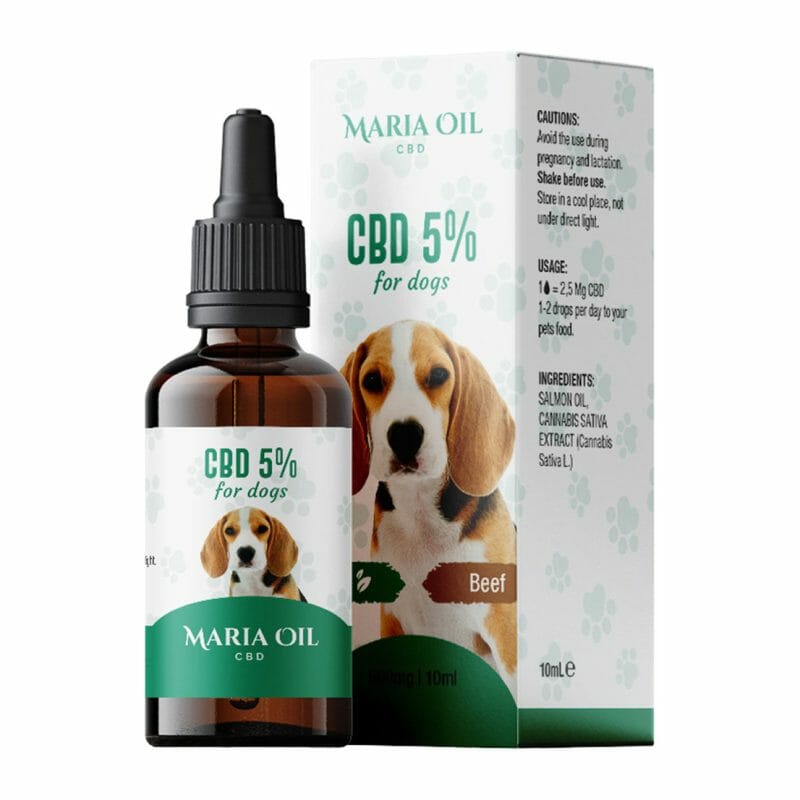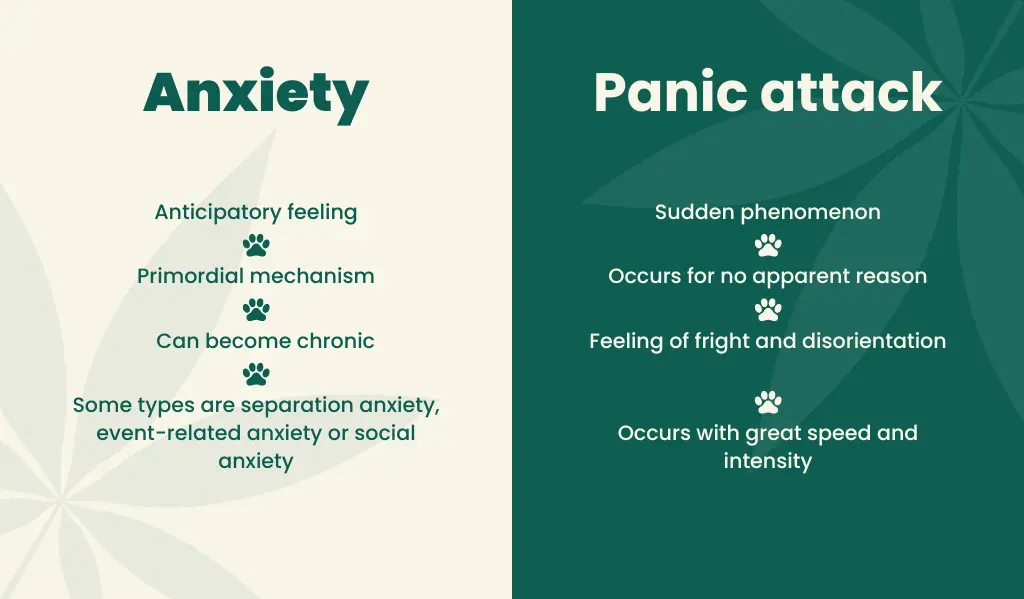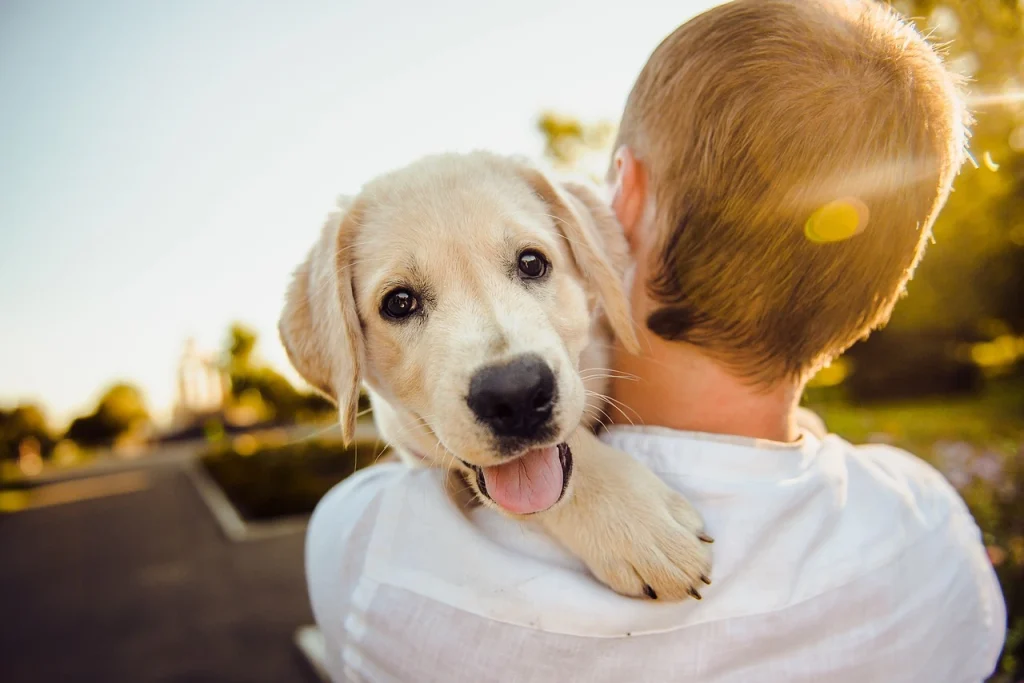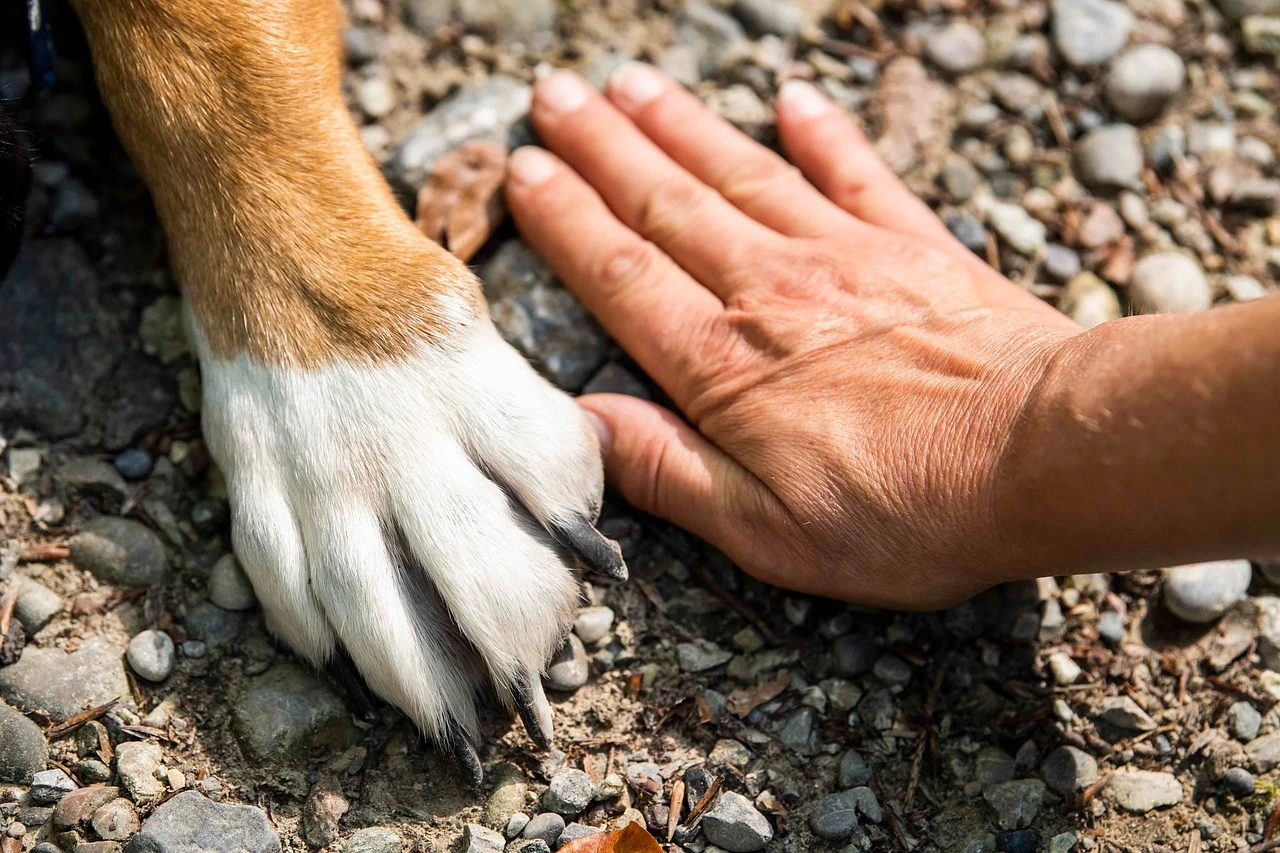Many people do not know it, but even our four-legged friends, whom we often consider members of our family for all intents and purposes, can suffer from anxiety and panic attacks. The causes can be manifold and generate in the animal a state of anxiety and stress that potentially leads to the activation of anxious behaviour very similar to that of humans. These episodes, although not always easily recognisable, can have a significant impact on our dog’s quality of life.
Learning to recognise the triggers and specific symptoms of panic attacks in dogs at an early stage is the first essential step towards effective intervention. Only through an in-depth understanding of what triggers such reactions in our furry friend can we be able to take the necessary measures to prevent them, treat them with the appropriate approach and, finally, cure them so that our dog can return to a peaceful and healthy life.
-
Product on sale
 CBD Crunchies for Dogs Chicken and TurkeyOriginal price was: £24.99.£14.99Current price is: £14.99.
CBD Crunchies for Dogs Chicken and TurkeyOriginal price was: £24.99.£14.99Current price is: £14.99. -
 CBD Oil 5% for Dogs£19.99
CBD Oil 5% for Dogs£19.99
What is a panic attack in dogs
Panic attacks in dogs arise from a deep feeling of fear, stress or very strong emotions that induce a series of recognisable behavioural manifestations and symptoms. In particular, these include trembling, difficulty breathing, excessive salivation, attempts to escape or hide (e.g. scratching at doors) and compulsive mechanisms such as continuous barking, yawning, licking and chewing.
If these behaviours are not addressed and resolved in time, anxiety can become chronic and, as a result, manifest itself repeatedly over time, leaving our four-legged friend in a state of constant excitement, unable to cope and endure stress.
Difference between anxiety and panic attack in dogs
Before we discover together how we can take action to help our dog, let us clarify the difference between anxiety and panic attack.
Anxiety is the feeling of anticipation, what any living organism activates before a situation perceived as dangerous. It is a primordial mechanism, the instinctive drive that makes any animal, or human being, run for cover from the imminent threat. Very often, anxiety becomes chronic and thus takes on a persistent character, eventually becoming a long-term response to stressful and anxiogenic situations.

As can be seen from the image above, there are many types of anxiety in dogs, the most common being:
- Separation anxiety: many dogs show signs of anxiety when they realise their owner is about to leave the house, which include crying and compulsive chewing.
- Anxiety during thunderstorms or fireworks: these two phenomena are known to frighten and put our four-legged friends in an anxious condition, and they may begin to tremble, hide, seek help from their owner, pant or lick themselves constantly.
- Social anxiety: when in the presence of other dogs or unknown people, some dogs may engage in avoidance behaviour, stiffness, barking or trying to hide behind their owner.
A panic attack, on the other hand, is a sudden and unexpected phenomenon that erupts without any apparent reason, leaving both dog and owner frightened and disoriented. Unlike general anxiety, a panic attack occurs with a rapidity and intensity that can be truly alarming. Therefore, recognising its symptoms and acting promptly is essential to minimise the animal’s discomfort and prevent further episodes.
But, before moving on to the symptoms of a panic attack in dogs, let us look at the causes together.amo insieme le cause.
Causes of panic attacks in dogs
The origin of panic attacks varies from dog to dog but experts have been able to group them into three macro categories:
- Physical and environmental factors: the environment surrounding a dog can have a substantial impact on its quality of life and represent, in certain contexts, a very important trigger when it comes to panic attacks. Loud and sudden noises, changes in routine, new spaces and unfamiliar people can trigger fear, anxiety and stress in dogs.
- Past traumas: when adopting a dog, you must always be careful to consider what it has been through before our arrival. Dogs with a traumatic past, for example, that have been abandoned, mistreated or have experienced frightening events, can experience emotions of fear, anxiety and stress in situations that recall the trauma.
But not only that, even the simple act of taking it to the vet for a visit that was difficult and frightening for the animal can cause it to have panic attacks on the way to the destination.
Individual emotional response of the dog: breed, age, general health and levels of socialisation are all elements that can influence the individual personality of a dog. More sensitive and shy dogs tend to be more likely to experience panic attacks.
Symptoms of panic attacks in dogs
Let’s look in detail at the most common symptoms that a dog suffering from panic attacks can show and that it is important for the owner to recognize:
- Tremors;
- Panting (without previous physical activity or heat);
- Restlessness;
- Barking and whining;
- Unusual and unexpected aggression;
- Avoidance;
- Lip licking and yawning;
- Attempts to escape;
- Hiding;
- Vomiting;
- Freezing and stiffening;
- Drooling;
- Stopping suddenly;
- High heart rate;
- Digging in unusual places in the house;
- Seeking the comfort and protection of the owner;
- Bouts of diarrhoea.
The duration of these episodes can vary from a few minutes to hours, depending on the trigger and the surrounding environment. A panic attack triggered by fireworks or thunderstorms can end once the noise stops completely or last a little longer. Fear caused by a visit to the vet, on the other hand, may take longer to vanish, at least until the dog has been brought home and finally feels safe there.
There are also particular cases in which the distressing feeling that our pet experiences can last for days and, every time he finds himself in that specific trigger situation, increases in severity and intensity.
At this point you may be wondering: how can I, therefore, help my dog feel better? In the next paragraph we propose five measures that the owner must implement every day to keep their pet under control and, if necessary, intervene promptly.male e, nel caso, intervenire tempestivamente.
3 right attitudes to help them
Animals of all species communicate mainly through body language. How many times do we feel sad, demoralised or stressed and notice that our four-legged friend approaches us, in an obvious attempt to comfort us?
This happens because animals are very skilled at perceiving and interpreting our emotions and, not surprisingly, their closeness is very often useful in treating certain types of disorders.
Here are three right attitudes that anyone can implement in an attempt to calm and reassure their dog:
1. Reassure them with affectionate gestures
Your presence is very important for your dog, in many moments of their life, especially those of suffering and stress. Sitting next to him, cuddling him and talking to him softly will be of great support in overcoming the panic attack.
In short, in the most critical moments your presence represents a real emotional anchor for the dog and helps to further strengthen your relationship of trust and love.
2. Stay positive and in a good mood
Just like us, they need to be reassured and feel protected. It is, in fact, a mutual exchange of affection. If your dog is having a panic attack, keeping a calm, positive attitude will help them calm down and overcome the crisis. On the contrary, appearing worried and nervous will only amplify its state of agitation and stress.
This little trick will not only support the dog, it will also strengthen your bond of mutual trust, contributing to creating an environment where you and your four-legged friend can face these difficult moments with greater serenity.
3. Shift their attention elsewhere
During a panic attack, another useful thing to do is creating play stimuli that keep him busy for a long time. This way, the dog will eventually relax faster, since their mind will be occupied by new positive thoughts and distracted from the source of stress.
Taking them out, moving him in a quieter place, using puzzle toys, giving them tasty food or having them perform simple commands rewarded with treats are simple and immediate examples that anyone can implement in times of need.

If the dog does not calm down and needs a repeated and long-term approach, two effective techniques that experts recommend to use are desensitisation and counterconditioning:
- Desensitisation: this is a method that involves gradually exposing the dog to the event that triggers the panic attack. In this way, your four-legged friend will gradually stop associating the situation with feelings of anxiety and panic, until he becomes immune to them.
For example, if he suffers from separation anxiety, it will be enough to start by simulating typical behaviors that the dog recognizes and associates with when you are about to leave the house, such as putting on shoes, a jacket and taking the keys, without initially going out. - Counterconditioning: this technique consists of introducing a treat, a treat or a caress within the context of the stressful situation for the dog. In this way, the animal will gradually begin to associate the stimulus that causes fear or anxiety with something pleasant and reassuring.
With time and repetition, the dog may end up changing his emotional reaction, going from fear to a positive expectation linked to the reinforcement received.
Natural remedies for panic attacks in dogs
If none of the methods and techniques discussed so far work, it would be ideal to resort to some additional support for the well-being of your dog.
There are many medications that the vet can prescribe, or that can be purchased at the pharmacy, but it is important to consider that, although they can offer immediate relief, in the long run they can have unwanted side effects and be harmful to your furry friend.
An alternative solution, equally effective, involves the use of natural remedies. These remedies, often based on herbs or natural ingredients, are able to help the animal find relief from the symptoms of anxiety and stress, allowing him to return to a calm state without compromising the health and general well-being of his body.
Here is a list of the most popular natural products in the treatment of panic attacks in dogs:
- CBD Oil for Dogs: Dogs have an endocannabinoid system (ECS), similar to that of humans, which regulates basic physiological functions such as pain, mood, appetite, sleep and immune response. CBD, a natural compound derived from the cannabis plant, binds to CB1 receptors, found in the brain and central nervous system, reducing anxiety and stress, and to CB2 receptors, located in the immune system and peripheral tissues, helping to modulate the inflammatory response and reduce pain.
Thanks to these properties, CBD can calm the nervous system of the dog, alleviating symptoms of anxiety and stress, as well as providing natural pain relief without the side effects of conventional medications.
In addition, it supports the immune system and, as it does not contain THC, it does not alter the mental state of the dog, making it safe for regular use. However, it is always advisable to consult with your veterinarian before starting a treatment with CBD to ensure that it is suitable for the specific needs of your dog. - Homoeopathic remedies: Aconitum napellus, Phosphorus and Pulsatilla can be useful for managing panic attacks in dogs thanks to their specific properties that act naturally and gently on the nervous system.
Aconitum napellus is often used to treat states of sudden fear and acute anxiety, helping to calm the dog during panic episodes.
Phosphorus is indicated for particularly sensitive and nervous dogs, with a predisposition to anxiety and fear, while Pulsatilla is useful for dogs that tend to be emotional and dependent, helping to stabilise their emotions in times of stress. - Calming Herbs: Chamomile, valerian, and St. John’s Wort can be helpful in managing panic attacks in dogs due to their natural relaxing and anti-anxiety properties. Chamomile is known for its calming effect on the nervous system, helping to reduce anxiety and promoting muscle relaxation. Valerian, another herbal remedy, is often used for its powerful natural sedative effect, which can help calm dogs during high-stress or panic situations. St. John’s Wort has properties that can improve mood and reduce anxiety, helping to stabilise the emotional state of the dog.
- Essential Oils: These are concentrated extracts obtained from plants, flowers and herbs and can be useful for managing panic attacks in dogs due to their powerful calming and relaxing properties. For example, lavender oil is known for its natural sedative effect, which can help reduce anxiety and stress, promoting a calm state in the dog.
This oil works on the nervous system, reducing tension levels and helping to stabilise mood, which is especially useful during a panic attack. To apply lavender essential oil, it is important to first dilute it in a safe carrier oil, such as coconut or almond oil, to avoid irritation. Once diluted, you can apply a small amount to the dog’s neck, back or paws, gently massaging the skin.
-
 CBD Oil 5% for Dogs£19.99
CBD Oil 5% for Dogs£19.99
Medical treatments
If, despite implementing all the remedies listed above, the panic attacks in the dog continue to increase in frequency and intensity, if you notice that he begins to assume destructive or dangerous attitudes or if he changes in his general behaviour (apathy, loss of appetite, sleep problems), then it is time to seek medical help.
There are three types of pharmacological therapies that can be undertaken:
- Pharmacological treatment: Anxiolytics or antidepressants, strictly prescribed by your veterinarian, can be useful in stabilizing your dog’s nervous system, reducing the anxiety and stress that lead to panic attacks.
These drugs work by regulating neurotransmitters in the brain, such as serotonin, which influence mood and the response to stress. - Complementary therapies: Complementary therapies such as acupuncture and massage can be extremely helpful in managing panic attacks in dogs, as they offer a natural and non-invasive approach to reducing anxiety and stress. Acupuncture, which involves inserting thin needles into specific points on the body, stimulates the release of endorphins and other chemicals that promote relaxation and reduce pain, helping to calm your dog’s nervous system.
Massage, on the other hand, can relieve muscle tension and promote a general sense of well-being, improving circulation and promoting a state of tranquillity. - Long-term therapeutic management: the drafting of a long-term therapeutic management plan, carefully developed and supported by expert professionals, can be extremely useful in the effective management of panic attacks in dogs. A structured and well-planned approach allows not only to deal with acute crises, but also to predict and prevent future episodes, significantly improving the quality of life of the dog and reducing stress for both the animal and the owner.
Conclusion
In conclusion, recognizing a panic attack in your dog and knowing how to intervene promptly is essential for the well-being and serenity of our furry friend. These episodes, if not managed correctly, can have a lasting impact on the dog’s quality of life, making timely intervention crucial.
Furthermore, understanding the causes that can trigger a panic attack is equally important. Environmental factors, past traumatic experiences and the dog’s individual sensitivity are absolutely not to be underestimated. Identifying and recognizing these factors allows not only to intervene effectively during an attack, but also to adopt preventive measures to reduce the probability of their repetition.
 Contact us
Contact us 






